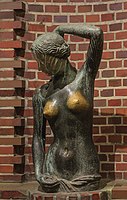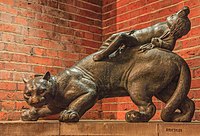Bernhard Hoetger


Bernhard Hoetger (4 May 1874 in Dortmund – 18 July 1949 in Interlaken) was a German sculptor, painter and handicrafts artist of the Expressionist movement.
Life
Hoetger was the son of a Dortmund blacksmith, he studied sculpture in Detmold from 1888 to 1892, before directing a workshop in Rheda-Wiedenbrück. After a spell at the Düsseldorf Arts Academy, he took a trip to Paris, where he was deeply influenced by Auguste Rodin, but also got to know Paula Modersohn-Becker. Later he was able to familiarise himself with Antoni Gaudí. In 1911, Hoetger was called up to the "artistic colony" of Darmstadt, where he was to remain for some time.
In 1914, inspired by Modersohn-Becker, he got to Worpswede. It was here where he met with Bremer's Ludwig Roselius, with whom he would go on to make his masterpiece, Bremen's Böttcherstraße, in an Expressionist style. When Hitler denounced the art & architecture in the Boettcherstrasse, Roselius contemplated suicide, but his niece Barbara Goette intervened with Hitler in Berlin and Café HAG, Roselius' corporation, invested heavily in Focke-Wulf consequently outmanoeuvering Hitler.[1]
Like his patron Ludwig Roselius, Hoetger sympathised with the Nazi ideals and became a member of the Nazi Party. He moved to Berlin in 1934 and tried, in vain, to instill himself through his art into the party, but in 1936 Hitler declared it to be degenerate art. Expelled from the party, in 1943 Hoetger fled to Switzerland, where he died in 1949.
-
The “Niedersachsenstein” in Worpswede, Germany.
-
Lion Gate at Darmstadt (with Albin Müller)
-
Jugend (Youth) Torso in Bremen, Böttcherstraße
-
Sculpture "Puma carrying the Day" in Bremen, Böttcherstraße
References
- ^ Leidig, Ludwig. Bombshell. sbpra 2013. ISBN 978-1-62516-346-2
External links
 Media related to Bernhard Hoetger at Wikimedia Commons
Media related to Bernhard Hoetger at Wikimedia Commons- Bernhard Hoetger in the German National Library catalogue
- 1874 births
- 1949 deaths
- German architectural sculptors
- Expressionism
- 19th-century German painters
- German male painters
- 20th-century German painters
- German sculptors
- People from Dortmund
- People from the Province of Westphalia
- Kunstakademie Düsseldorf alumni
- 20th-century German sculptors
- German male sculptors
- 19th-century sculptors




